Healthier Hens Y2.5 update and new avenues
By lukasj10🔸, Isaac_Esparza @ 2024-04-19T16:55 (+58)
TL;DR
Healthier Hens (HH) aims to improve cage-free hen welfare, focusing on key issues such as keel bone fractures (KBFs). In the last 6 months, we’ve conducted a vet training in Kenya, found a 42% KBF prevalence, and are exploring alternative promising interventions in collaboration with the Welfare Footprint Project, publishing transferrable findings along the way. Our staff satisfaction remains high, but concerns about operational capacity are on the rise. We're deciding on future strategies, considering funding and organizational changes. Our budget for Y3 (‘23 Sep - ‘24 Sep) is $65k-$135k, with a $0-70k funding gap.
In this post, we share key updates, lessons learned and our plans for immediate next steps. We hope others can benefit from what we’re observing and our attempts to identify promising pathways towards improved hen health and welfare. We welcome feedback from the community.
Key points
- Healthier Hens (HH) continues looking for ways to address major sources of cage-free egg-laying hen pain such as keel bone fractures (KBFs) through data collection and capacity building.
- Consider reading our introductory, 6M, 1Y, 1.5Y and 2Y update posts to learn more about our background, mission and updated approach. Due to funding constraints, we had downscaled last year and continue running lean, focusing on identifying promising avenues via mini-projects before piloting anything on the ground.
- Our Y3 (Sep ‘23 - Sep ‘24) budget will mainly comprise of outreach, staff, travel, and potential research activity costs. We raised $65k for this year’s work.
- In our ongoing scoping efforts in Kenya we conducted a KBF baseline case study, a vet training workshop on hen welfare, and are exploring a certification scheme and alternative promising interventions. We continue publishing details on how we go about seeking impact for the hens, including outcomes and lessons learned for others to incorporate in their activities.
- Our mid-year staff survey revealed overall satisfaction with our culture and values but also some concerns about time commitments and task distribution. Although there is room for improvement, we all still agree that hen welfare is our priority.
- Our next strategic decision-making point is in May 2024, where we’ll choose a scenario from a pool ranging from shutting down to trialling a couple of interventions, depending on the final impact and cost-efficacy estimates.
- Our funding gap is small and scenario-dependent. Our runway is flexible (3M max.). We will need $0-75k for the second half of 2024.
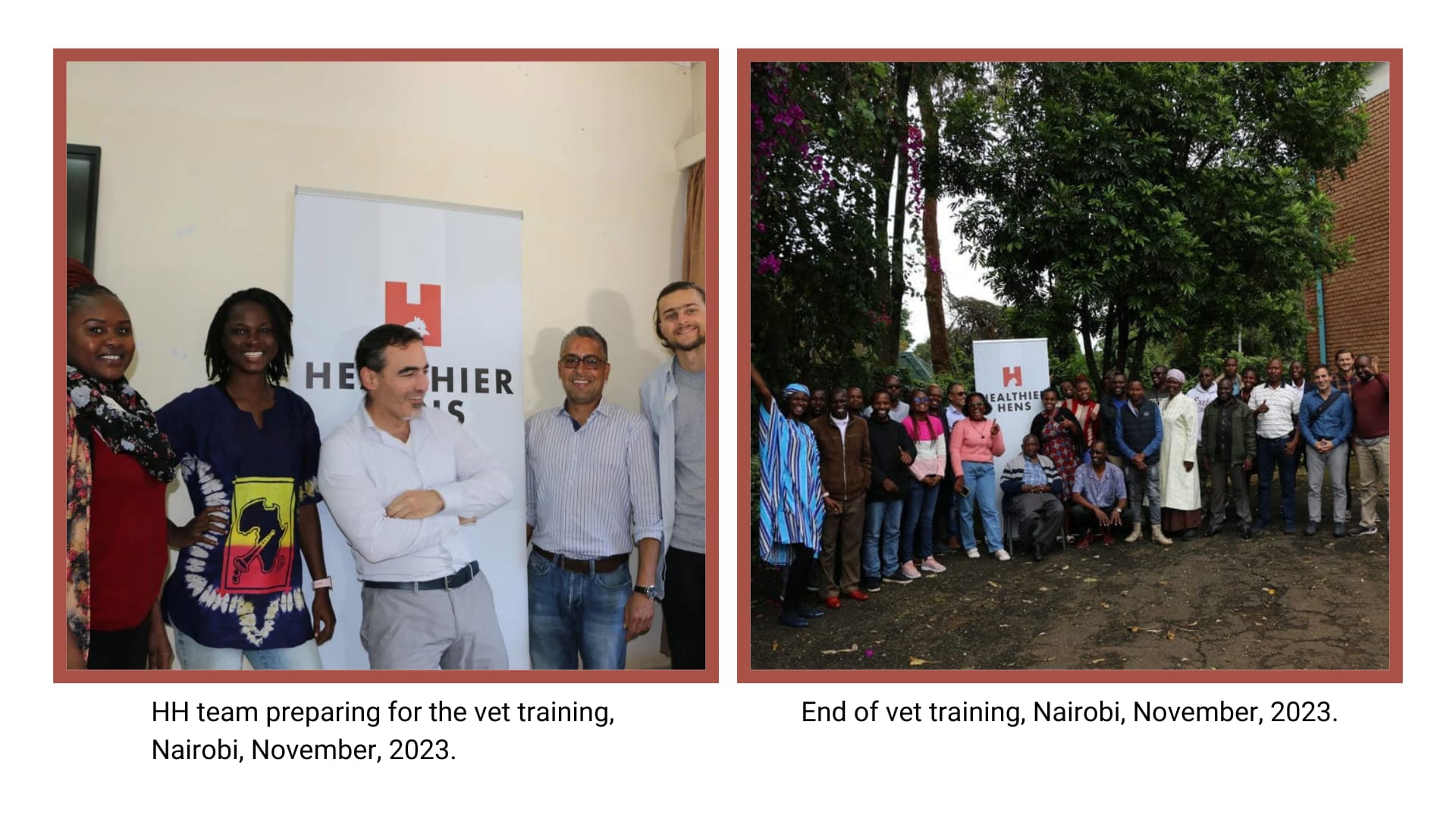
Specific HH Y2.5 updates
- In-person veterinarian training (full report here):
- We partnered with the University of Nairobi and held a two-day training for vet professionals, who visit farms routinely. The main purpose of the training was to provide knowledge on proper hen welfare and grow on-farm assessment capacity among active professionals.
- We had received over 70 applications and invited 22 veterinarians to attend, 18 of whom attended. Our training was approved by the Kenya Veterinary Board as a Continuing Professional Development (CPD) activity earning the participants 16 CPD points each - a factor that significantly incentivised the participants.
- Over two days, 9 experts from various fields provided class lectures and practical sessions in the veterinary surgery room. We concluded the training with a site visit to a cage-free farm to perform on-farm welfare indicator assessments.
- We conducted pre-, post- and 2-month-post surveys to evaluate the outcomes of the training. Additionally, a key informant survey was conducted six weeks after the training with two participants to acquire free-form feedback on the practical application of the learned skills in their fieldwork.
- The results showed positive results, indicating increased knowledge and motivation among participants. However, some variations were noted in recognizing good hen welfare practices, emphasising the need to address outdated beliefs such as ones concerning debeaking and the use of hormones.
- Overall, the training topics that the participants found the most interesting were “One health, one welfare”, “Hen welfare assessment with live hens & palpation”, “Understanding behaviour, stress & enrichment in hens”, “Post-mortem keel bone damage assessment”, and the panel discussion on “Showcasing good on-farm practices”.
- For HH, this mini-project helped establish a pipeline of practising veterinary professionals who are now exposed to practical hen welfare issues, including that of KBFs, paving the way for the potential implementation of future on-farm activities.
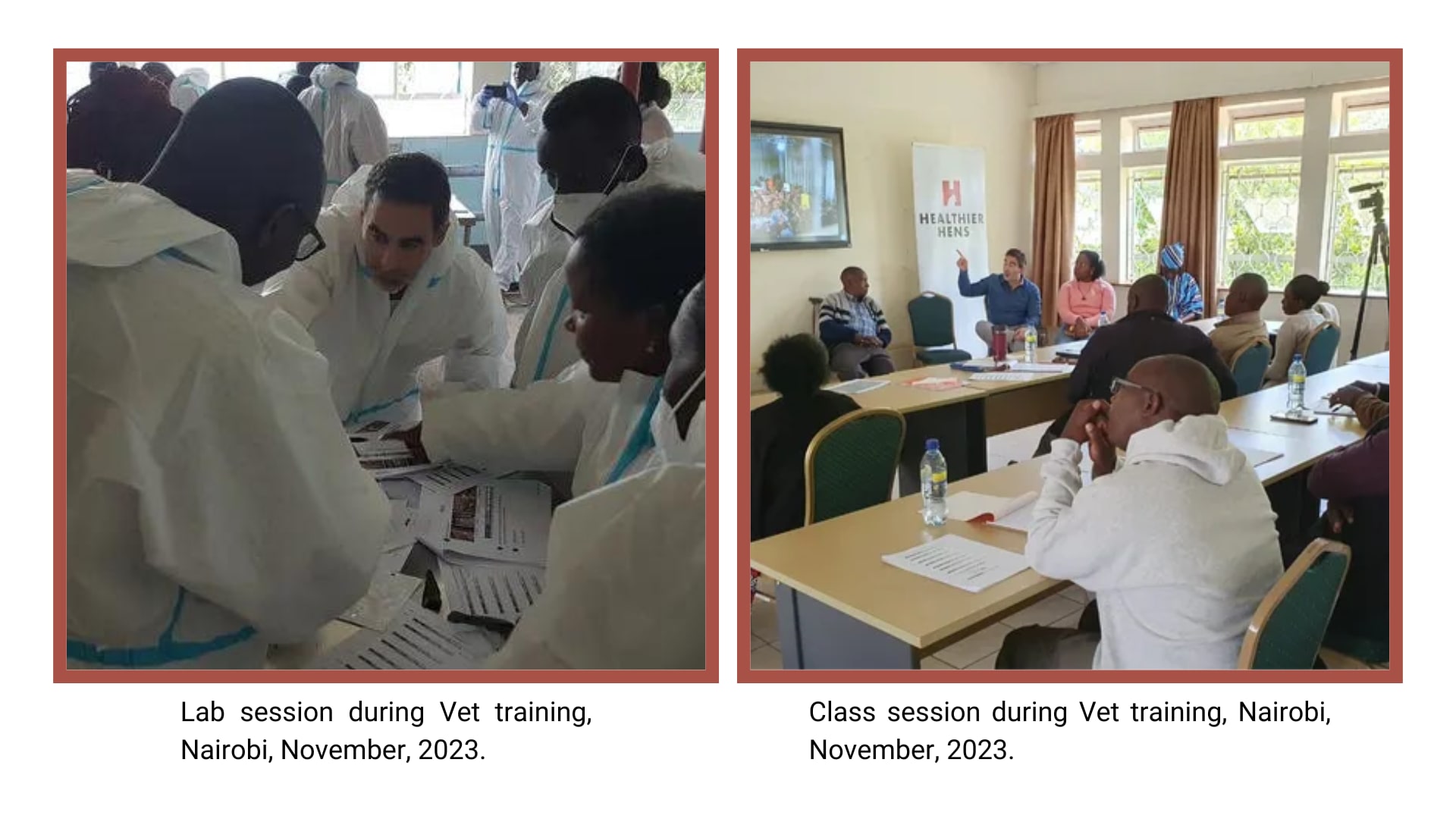
- Acquiring Afrocentric KBF data (full report here):
- We concluded our scoping case study evaluating five cage-free farms for KBF prevalence and severity.
- A total of 100 keel bones from end-of-lay hens were scored by getting them radiographed at the Pathology Department of the University of Nairobi and assessing their status independently.
- The overall average prevalence of KBFs was 42% (20-65%), a figure well within previously published review ranges of 13.5-71% and 13-84.5% from the Global North.
- Radiographic assessments indicated a relatively low average fracture severity score (2 compared to >3 in Global North data, using a 0-5 scale), possibly influenced by differences in housing systems and/or other potentially protective factors.
- At the two last cage-free farms, two trained vet professionals also performed keel bone evaluations via live palpation, also evaluating other hen welfare indicators.
- Given the documented feed quality issues and inconsistent farm management practices, we had expected to observe higher KBF prevalence and/or severity.
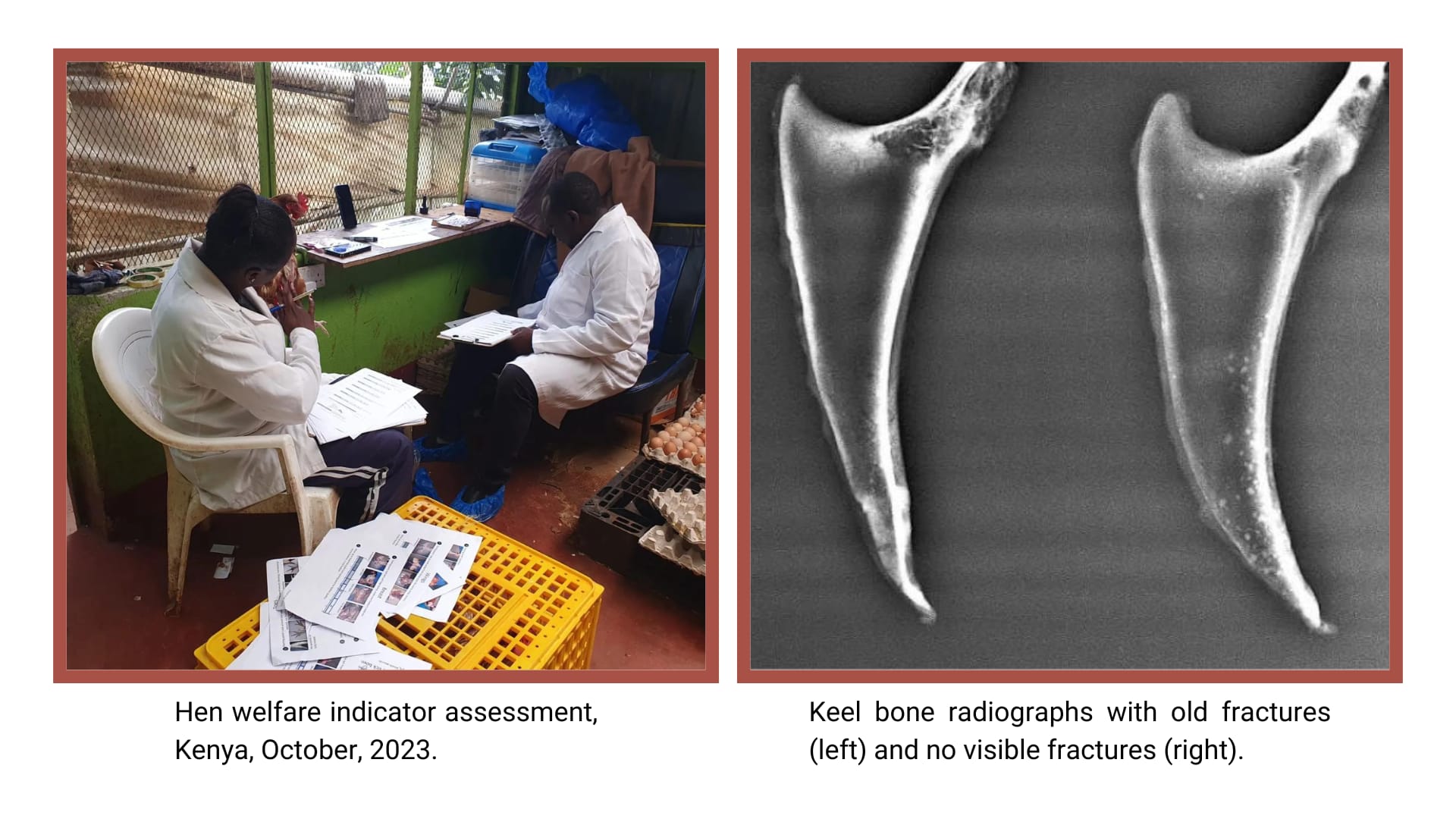
- Facilitating Certified Humane® entry in Africa
- We were able to identify several cage-free farms that are interested in becoming certified.
- We also connected with several retailers that have made cage-free commitments and are willing to potentially agree to partner with the farm to help meet these commitments.
- Our next step is to identify how many changes, and the costs associated with those changes, the farms need to make to become certified.
- Scoping alternative promising interventions (full farm visit report here)
During farm visits and on-farm welfare scoping, we noticed prevalent issues that went beyond bone health. Initially, we identified 4 priority areas for intervention scoping: biosecurity, thermal stress, feed/water access, and veterinary support. Initial quantitative assessments revealed the potential impact and cost-effectiveness of interventions in alleviating pain and improving welfare outcomes. To quantify and prioritize several of the observed issues, we are collaborating with the Welfare Footprint Project, who help us estimate the time in pain hens are exposed to due to these welfare issues. Measures aimed at addressing thermal stress, and improving hen access to feed and water show promise in reducing significant amounts of hours spent in pain cost-effectively. Example initial estimates:
| Welfare issue | Total impact [hours of disabling pain averted/farm] | Cost efficacy [$/hen] | Cost efficacy [$cents/hour of disabling pain] |
| Thermal stress | 87.5k (46.25k-150k) | 0.77 | 1.11 (0.65-2.09) |
| Limited access to water | 23.75k (12.5k-35k) | 0.17 | 0.9 (0.61-1.71) |
| Limited access to feed (feeders) | 162.5k (103.75k-212.5k) | 0.22 | 0.17 (0.13-0.27) |
| Limited access to feed (feeders + feed) | 362.5k (250k-475k) | 1.43 | 0.49 (0.38-0.72) |
For comparison, the only real benchmarks we have until now are impact estimates of farmer training workshops (0.44 $/hen) and our overall activities (27 $/hen), the impact of which was expressed through Welfare Points: net 95k Welfare Points affected, as per our previous post. {EDIT} Please see @MichaelStJules comments with external benchmarks below.
We are now going through the data collected during our follow-up farm visits. This exercise was intended to get more targeted data that will help us test some of our initial assumptions and, hopefully, get a better estimate of how much hen pain is actually at stake.
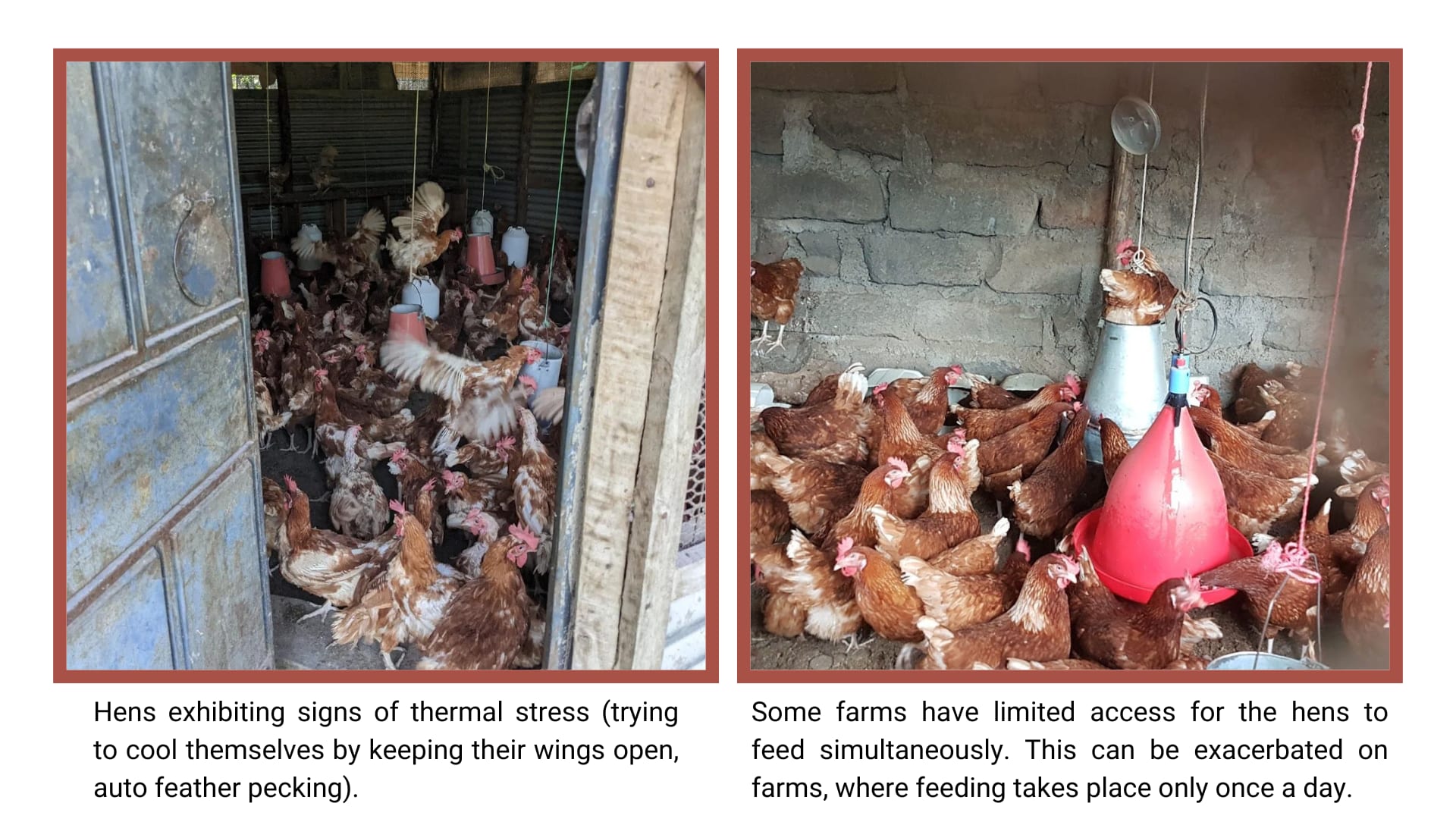
- Team evaluation
We surveyed our staff in February. Staff agree that the organisation’s culture and values have been upheld in the face of uncertainty. Time commitments, communication, and division of labour are areas that need improvement. Staff worry that if these areas are not improved it would further diminish job satisfaction and the clarity around our objective. Although there is some apprehension around the next steps, we all strongly agree that “we incorporate improving the lives of hens into our day-to-day decisions”.
- Conferences, presentations, events
Our Country Manager, Faisal Qureshi, attended the African Animal Welfare Conference in Kigali, Rwanda. He joined representatives from animal welfare organisations across the African continent and took part in group discussions on how hen welfare can be addressed in the global south. Faisal also had the chance to be part of the conversation at the second gathering of the growing Africa Cage Free Farming Coalition in Kenya.
Lukas Jasiunas had the opportunity to present and answer questions at Fauna Connections. He shared how over the past year, we looked into Kenyan feed quality, farmer awareness of hen welfare, and on-farm welfare issues on small-scale commercial cage-free farms (watch the short presentation here).
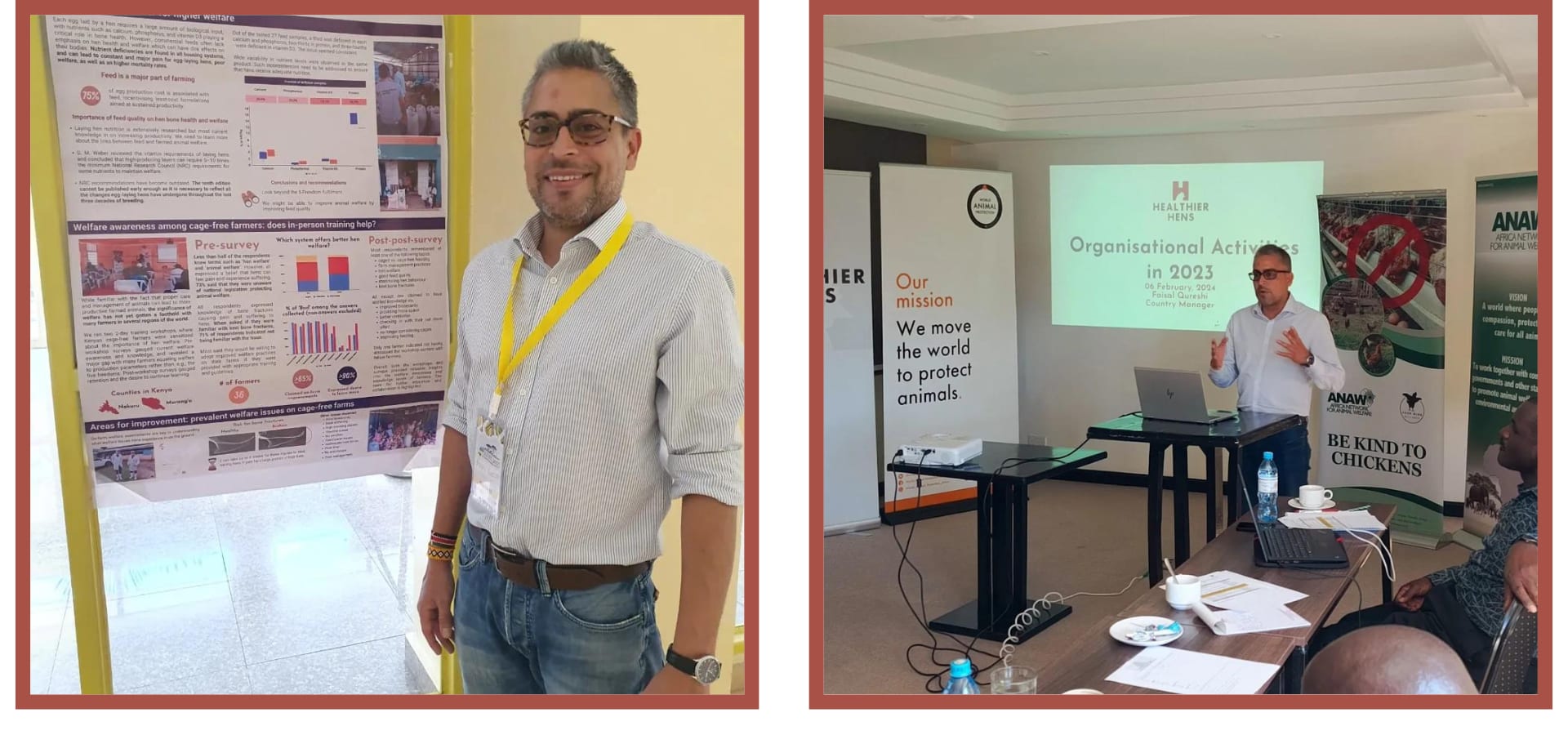
| African Animal Welfare Conference, Kigali, Rwanda, September, 2023. See the poster here. | Africa Cage Free Farming Coalition meeting, Naivasha, February, 2024. See the slides here. |
Next steps
As we are about to wrap up our follow-up work from the mini-project activities, we have made several key decisions already, but a couple of options remain open on what paths could be worthwhile for us to pursue. The decisions will once again be informed by the data gathered and expected value estimates. Actionable strategic questions already considered:
- KBF Baseline follow-up via a feed trial - voting outcome: no.
- Cons: uncertain impact, expensive.
- KBF Baseline follow-up via further research - voting outcome: yes.
- Pros: learn more on potential protective factors.
- Vet training follow-up with one more training - voting outcome: no.
- Cons: no or limited impact on the hens, difficult operationally, not much additional value for HH ops.
- Promising intervention follow-up through trialling - voting outcome: no.
- Cons: high uncertainty and risk, expensive, not enough operational capacity.
- Promising intervention follow-up through more research to get better data and reduce uncertainty - voting outcome: yes.
- Pros: makes sense given limited operational capacity, getting better data is cheap and beneficial.
- Certified Humane follow-up via visiting farms to suggest ways of getting compliant with minimum requirements - voting outcome: yes.
- Pros: a good way to follow-up after vet training, such cage-free support work is good for the local movement.
- Certified Humane follow-up via starting the search for a Kenyan Inspector - voting outcome: no.
- Cons: we do not have farms on board, Certified Humane would only hire when there is traction.
- Certified Humane follow-up via trying to partner with retailers to agree to subsidize farmer costs - voting outcome: yes.
- Pros: could be a very useful step, one that’s worth piloting for on-farm impact for the hens.
We might decide to shut down despite any data collection outcome due to organisational challenges: capacity constraints (⅔ co-founders moving into full-time positions elsewhere) and the potential need to grow quickly. It will be a call on whether we can deliver what we believe is worth pursuing. Nonetheless, a decision to shut down would still see us through dissemination and community engagement activities to ensure that the work already done informs future activities.
Finances
We have raised a bit over $65k for our Y3 operations from ACE and Craiglist Funds. Until now, we were able to stay below budget and had enough funds to do the additional follow-up activities.
Budget overview:
Y3 sees more of our budget accounting for outreach activities (¼, mainly events for knowledge dissemination), Kenya staff costs (⅕) and travel expenses (⅕). Should we decide to trial interventions (see Next steps section above) in the end, the research activity bracket would increase 4-10 times. The total estimated Y3 budget, depending on the scenario we will follow, will be $65-135k.
Funding gap for 2024:
Depending on the chosen scenario, we will aim to raise $0-70k for programme work. Ideally, we would also manage to raise extra for operations, ensuring that a higher FTE can be allocated. If deemed necessary, we will apply to larger EA farmed animal welfare grantmakers to acquire the needed funds.
Staying up-to-date
To stay in the loop with what we’re up to, consider subscribing to our newsletter - the next one’s about to be sent out!
Since we are constantly reevaluating things internally (next major re-eval point: May 2024), we would like to invite EA community members to provide us with feedback, concerns or suggestions anonymously. If this is not the first time you’ve heard about HH and what we have been up to, please consider filling out this short form and help us make better decisions. Thanks!
Finally, if you’d rather chat in person, please meet us at AVA (Kiki), EAG:London (Kiki and Lukas), EAGxNordics (Lukas) and CARE (Lukas) later this year. Thank you!
MichaelStJules @ 2024-04-20T07:40 (+3)
Measures aimed at addressing thermal stress, and improving hen access to feed and water show promise in reducing significant amounts of hours spent in pain cost-effectively. Example initial estimates:
Welfare issue Total impact
[hours of disabling pain averted/farm]Cost efficacy
[$/hen]Cost efficacy
[$cents/hour of disabling pain]Thermal stress 87.5k (46.25k-150k) 0.77 1.11 (0.65-2.09) Limited access to water 23.75k (12.5k-35k) 0.17 0.9 (0.61-1.71) Limited access to feed (feeders) 162.5k (103.75k-212.5k) 0.22 0.17 (0.13-0.27) Limited access to feed (feeders + feed) 362.5k (250k-475k) 1.43 0.49 (0.38-0.72)
For the most promising, limited access to feed (feeders), at 0.17 cents/hour of disabling pain, this is around 0.067 years of disabling pain/$. It's worth benchmarking against corporate campaigns for comparison. From Duffy, 2023, using disabling pain-equivalent:
1.7 years of suffering avoided per dollar that was spent on cage-free campaigns, with a range between 0.23 and 5.0 years per dollar.
At first, this looks much less cost-effective, 1.7/0.067 = 25. However, Emily Oehlsen from Open Phil said
We think that the marginal FAW funding opportunity is ~1/5th as cost-effective as the average from Saulius’ analysis.
And Duffy's estimate is based on the same analysis by Saulius. So, more like 5x less cost-effective. However, Duffy's estimate also included milder pains:
Table 25: Cage-free corporate campaign cost-effectiveness by pain type
Lower Bound (yrs. pain avoided/$/yr.) Average Estimate (yrs. pain avoided/$/yr.) Upper Bound (yrs. pain avoided/$/yr.) Weight Excruciating -0.000002 -0.000002 -0.000002 5 Disabling 0.019 0.052 0.107 1 Hurtful 0.10 0.39 0.88 0.15 Annoying 0.35 0.91 1.7 0.01 Suffering-
equivalent
0.05 0.12 0.23 1
More than half of the equivalent hours of disabling pain is actually not from disabling pain at all, instead hurtful pain. So a fairer comparison would either omit the hurtful pain for corporate campaigns or also include hurtful pain for this other intervention. This could bring us closer to around 2.5x, as a first guess, which seems near enough to the funding bar.
On the other hand, I picked the most promising of the interventions, and it's less well-studied and tested than corporate campaigns, so we might expect some optimizer's curse or regression towards being less cost-effective.
MichaelStJules @ 2024-04-20T07:47 (+5)
Another benchmark is GiveWell-recommended charities, which save a life for around $5,000. Assuming that's 70 years of life saved (mostly children), that would be 70 years of human life/$5000 = 0.014 years of human life/$. People spend about 1/3rd of their time sleeping, so it's around 0.0093 years of waking human life/$.
Then, taking ratios of cost-effectiveness, that's about 7 years of disabling chicken pain prevented per year of waking human life saved.
Then, we could consider:
- How bad disabling pain is in a human vs a chicken
- How bad human disabling pain is vs how valuable additional waking human life is
- Indirect effects (of the additional years of human life, influences on attitudes towards nonhuman animals, etc.)
lukasj10 @ 2024-04-20T13:25 (+5)
Thanks for providing these external benchmarks and making it easier to compare! Do you mind if I updated the text to include a reference to your comments?
Indeed, since these were initial estimates, we excluded reporting the other pain intensities to keep it brief. However, once we go through the follow-up data and have the second set of estimates, we'll make sure to include all of the ranges, so that more comprehensive comparisons could be made. But my understanding is that for water and feed, it could be ~1:5:7 (disabling:hurtful:annoying) and ~1:1:0.1 for heat stress.
But your caveat is very important - we've only just identified this as an interesting intervention for the Global South, the feasibility of cost effectively mitigating such welfare issues remains untested.
MichaelStJules @ 2024-04-21T02:30 (+4)
Thanks for providing these external benchmarks and making it easier to compare! Do you mind if I updated the text to include a reference to your comments?
Feel free to!